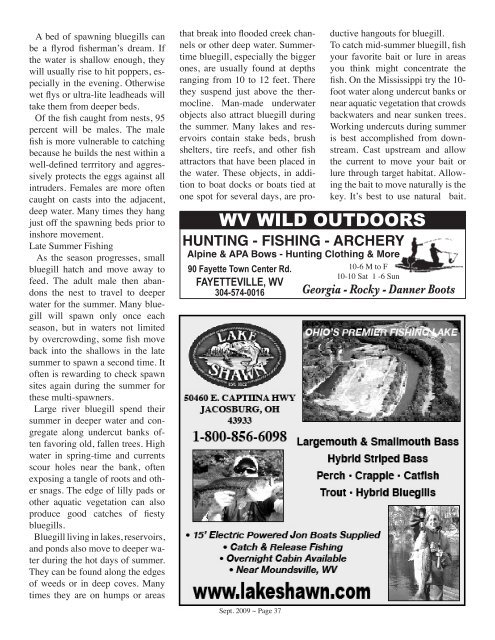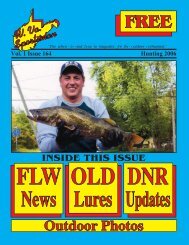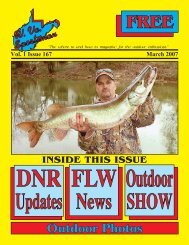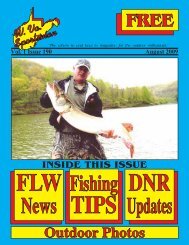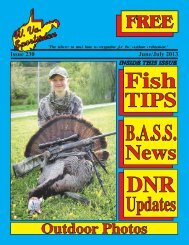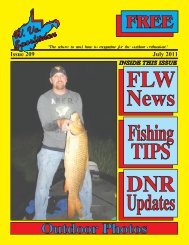Outdoor Photos - W.Va. Sportsman Online!
Outdoor Photos - W.Va. Sportsman Online!
Outdoor Photos - W.Va. Sportsman Online!
You also want an ePaper? Increase the reach of your titles
YUMPU automatically turns print PDFs into web optimized ePapers that Google loves.
A bed of spawning bluegills can<br />
be a flyrod fisherman’s dream. If<br />
the water is shallow enough, they<br />
will usually rise to hit poppers, especially<br />
in the evening. Otherwise<br />
wet flys or ultra-lite leadheads will<br />
take them from deeper beds.<br />
Of the fish caught from nests, 95<br />
percent will be males. The male<br />
fish is more vulnerable to catching<br />
because he builds the nest within a<br />
well-defined terrritory and aggressively<br />
protects the eggs against all<br />
intruders. Females are more often<br />
caught on casts into the adjacent,<br />
deep water. Many times they hang<br />
just off the spawning beds prior to<br />
inshore movement.<br />
Late Summer Fishing<br />
As the season progresses, small<br />
bluegill hatch and move away to<br />
feed. The adult male then abandons<br />
the nest to travel to deeper<br />
water for the summer. Many bluegill<br />
will spawn only once each<br />
season, but in waters not limited<br />
by overcrowding, some fish move<br />
back into the shallows in the late<br />
summer to spawn a second time. It<br />
often is rewarding to check spawn<br />
sites again during the summer for<br />
these multi-spawners.<br />
Large river bluegill spend their<br />
summer in deeper water and congregate<br />
along undercut banks often<br />
favoring old, fallen trees. High<br />
water in spring-time and currents<br />
scour holes near the bank, often<br />
exposing a tangle of roots and other<br />
snags. The edge of lilly pads or<br />
other aquatic vegetation can also<br />
produce good catches of fiesty<br />
bluegills.<br />
Bluegill living in lakes, reservoirs,<br />
and ponds also move to deeper water<br />
during the hot days of summer.<br />
They can be found along the edges<br />
of weeds or in deep coves. Many<br />
times they are on humps or areas<br />
that break into flooded creek channels<br />
or other deep water. Summertime<br />
bluegill, especially the bigger<br />
ones, are usually found at depths<br />
ranging from 10 to 12 feet. There<br />
they suspend just above the thermocline.<br />
Man-made underwater<br />
objects also attract bluegill during<br />
the summer. Many lakes and reservoirs<br />
contain stake beds, brush<br />
shelters, tire reefs, and other fish<br />
attractors that have been placed in<br />
the water. These objects, in addition<br />
to boat docks or boats tied at<br />
one spot for several days, are pro-<br />
WV WILD OUTDOORS<br />
HUNTING - FISHING - ARCHERY<br />
Alpine & APA Bows - Hunting Clothing & More<br />
90 Fayette Town Center Rd.<br />
FAYETTEVILLE, WV<br />
304-574-0016<br />
Sept. 2009 ~ Page 37<br />
ductive hangouts for bluegill.<br />
To catch mid-summer bluegill, fish<br />
your favorite bait or lure in areas<br />
you think might concentrate the<br />
fish. On the Mississippi try the 10foot<br />
water along undercut banks or<br />
near aquatic vegetation that crowds<br />
backwaters and near sunken trees.<br />
Working undercuts during summer<br />
is best accomplished from downstream.<br />
Cast upstream and allow<br />
the current to move your bait or<br />
lure through target habitat. Allowing<br />
the bait to move naturally is the<br />
key. It’s best to use natural bait.<br />
10-6 M to F<br />
10-10 Sat 1 -6 Sun<br />
Georgia - Rocky - Danner Boots


